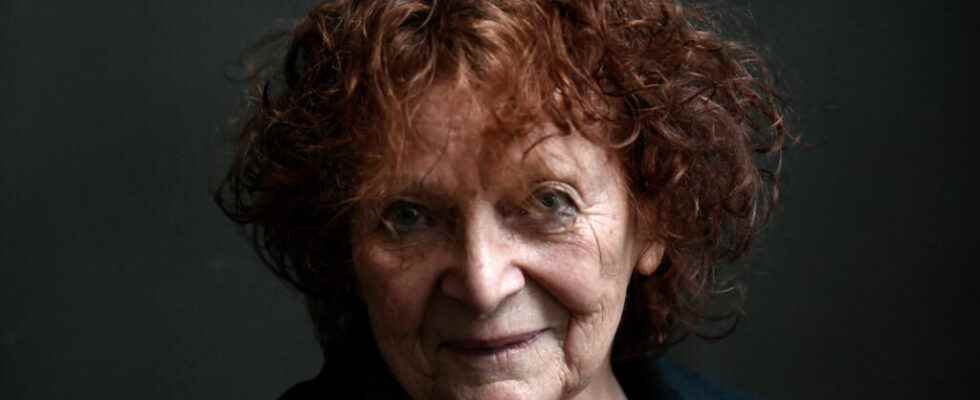It is the French writer and visual artist Claudie Hunzinger, 82, who won this Monday, November 7 in the first round the Femina 2022 prize for her novel “A dog at my table” (Grasset). The exclusively female jury thus crowned a work that is both feminist and devoted to the author’s very special bond with nature.
After the December award in 2019 forThe Great Deer, the Alsatian writer Claudie Hunzinger wins this Monday with her twelfth novel the prestigious Femina prize. His novel A dog at my table tells the story of a couple living in seclusion in the mountains who see their lives turned upside down by the arrival of a stray dog. A literary nod to her own life, which she has led since 1965 in a hamlet in the Vosges. In a literary thrust opposed to anthropocentrism, she offers us a deep reflection rooted in nature on animal and plant life, ecological disaster and old age.
What role for the Femina Prize ?
After Annie Ernaux, awarded the Nobel Prize for Literature, after Brigitte Giraudchosen for the biggest prize in the French language, the Goncourt prize, what is today the mission of the Femina, a French literary prize created in 1904 on the initiative of 22 collaborators of the magazine happy life to oppose a long openly misogynistic Goncourt prize (with a first winner in 1944)? Mission accomplished ? Or is there still a fashionable counter-proposal to defend an inclusive literature?
The nine members of the jury, including the Rwandan novelist Scholastique Mukasonga, under the chairmanship of Évelyne Bloch-Dano, obviously wanted to send a signal. In addition to the Femina prize for Claudie Hunzinger, it also awarded the Femina foreign prize and the Femina Essay prize to women, Rachel Cusk for The addictionan original work recounting a camera between three couples won over by pride, and Annette Wieviorka for Tombs : autobiography of my family. Among the last ten winners of the Femina prize are today, with Claudie Hunzinger, four women, including the Cameroonian writer Léonora Miano (2013), the Haitian author Yanick Lahens (2014) and the French Clara Dupont-Monod (2021 ).
In 1904, the first winner of the prize, then still called happy life, is Myriam Harry, followed in 1905 by Romain Rolland. Since then, many men have received the Femina prize, which has earned a reputation for going beyond the male/female divide. From the outset, the members of the jury took care to respect a balance that is both very difficult to achieve and to maintain in the face of the upheavals of contemporary society, between different forms of misogyny and the #MeToo movement.
The green life of Claudie Hunzinger, between plastic art and writing
Born April 9, 1940 in Alsace, in Colmar, the life of Claudie Hunzinger resembles a meandering river. After graduate studies in Paris for the drawing professorship, she settled with her companion Francis Hunzinger in a farm, without running water, in the Vosges to raise sheep there. She teaches a few more years in a high school before devoting herself entirely to her mountain dream which already appears in her first story, Bamboo, green lifepublished in 1973 and became a bestseller.
The 1980s were especially dedicated to his passion for plastic art and it is clear that the number of his exhibitions greatly exceeded the number of his published books. As an artist, she examines the violence done to the book in a metaphorical and physical way through rolls of charred writings and her series Ash bookcases, presented in prestigious venues such as the Hôtel Salomon de Rothschild in Paris, the Lausanne Biennale, the Bellerive Museum in Zurich and the Barbican Cultural Center in London. She even brings the writing of herbs into a library.
She publishes her first novel at the age of 70
In 2010, at the age of 70, she published her first novel, They lived in hope (Grasset), inspired by his very emancipated mother, a literature teacher and anti-fascist activist in his youth. Contrasting with the admiration for her mother, she always remained discreet in relation to her father, a teacher of Germanic culture and very marked by his childhood in the Alsace of William II. Afterwards, this admirer of Nathalie Sarraute and James Joyce never stopped writing the novel of her life: Survival (2012), The language of birds (2014), the incandescent (2016), The big stags (2019)…
His plastic work undoubtedly strongly influenced his novelistic work, with an organic language, seeking to merge the various and varied components, avoiding putting barriers between human, animal and organic lives. A challenge that has become urgent, going well beyond the divide between genres, and which is becoming more and more essential in many artistic fields such as movie theater and art.
